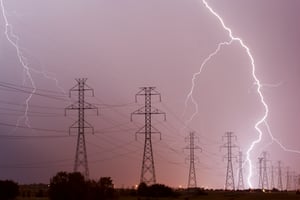In the dynamic world of power transmission, the management of line contingencies is undergoing a...
Enhancing Grid Reliability through AI-Enabled Contingency Management
ERCOT, responsible for managing the Texas electricity grid, has faced significant operational challenges in recent years. Winter Storm Uri in 2021 revealed vulnerabilities in the grid's resilience, prompting the Public Utility Commission (PUC) to approve new weatherization standards for generators and transmission providers. Despite these efforts, the recent cancellation of a request for proposals (RFP) for additional generating capacity indicated the difficulties in ensuring winter reliability, emphasizing the pressing need for innovative solutions.
In response to these challenges, ERCOT's CEO, Pablo Vegas, outlined plans to expand demand response resources in 2024 to enhance the electric system's reliability. Demand response, which incentivizes consumers to adjust their electricity consumption during peak times, is valuable in maintaining grid stability. This approach conserves energy and mitigates the risk of overloading the grid during extreme weather conditions.
However, the introduction of ERCOT's Contingency Reserve Service (ECRS) has initiated productive discussions and diverse viewpoints. The ERCOT Independent Market Monitor has voiced concerns, suggesting that ECRS has contributed approximately $12.5 billion in additional procurement of ancillary services since its inception. In response, ERCOT has noted that the rise in electricity prices can also be associated with factors such as a particularly warm summer and a substantial increase in peak demand. These differing perspectives underscore the complex challenges that grid operators face as they endeavor to uphold reliability, manage costs efficiently, and adapt to evolving market dynamics.
The Challenge of Grid Contingencies:
Grid contingencies, such as equipment failures, extreme weather conditions, and fluctuating electricity demand, can lead to power outages and disruptions. These challenges are exacerbated by the increasing complexity of modern power systems, which incorporate renewable energy sources, distributed generation, and evolving consumption patterns. Traditional contingency management methods often need help to address these dynamic challenges effectively.
AI-Enabled Contingency Management
Artificial intelligence, with its data analytics, machine learning, and automation capabilities, offers a transformative solution to enhance contingency management in the energy sector. Here's a case for the implementation of AI-enabled technology:
- Predictive Analytics: AI can analyze historical and real-time data to predict potential contingencies. Machine learning algorithms can identify patterns and anomalies, allowing grid operators to anticipate issues before they escalate. This proactive approach can significantly reduce the likelihood of power disruptions.
- Real-Time Monitoring: AI systems can continuously monitor grid parameters and sensor data. They can detect deviations from normal operating conditions, swiftly identify faults, and initiate automated responses. This real-time monitoring ensures a quicker and more precise response to contingencies.
- Autonomous Decision-Making: AI can automate decision-making processes during contingencies. For example, in the case of unexpected equipment failures, AI-enabled systems can reroute power flows, isolate affected areas, and optimize grid operations to minimize disruptions. This reduces human intervention and response times.
- Demand Response Optimization: Like ERCOT's plans for expanding demand response resources, AI can optimize demand response efforts by predicting peak demand periods and coordinating with consumers to reduce load during critical times. This not only enhances grid stability but also promotes energy efficiency.
- Enhanced Weather Forecasting: AI-driven weather forecasting models can provide grid operators with more accurate and timely information about impending severe weather events. This allows for better preparedness and proactive measures to mitigate potential disruptions.
- Grid Self-Healing: AI-enabled grid technologies can facilitate self-healing capabilities. When a contingency occurs, AI can automatically reconfigure the grid to bypass damaged or overloaded components, ensuring the continuity of power supply to unaffected areas.
- Data-Driven Decision Support: AI-generated insights and recommendations can empower grid operators with data-driven decision-support tools. This enables them to make informed choices regarding resource allocation, maintenance schedules, and infrastructure upgrades to prevent future contingencies.
Recent challenges faced by ERCOT, notably Winter Storm Uri, have underscored the critical importance of effective contingency management for grid reliability. The integration of AI-enabled technology offers a compelling solution, providing predictive analytics, real-time monitoring, autonomous decision-making, and demand response optimization. These AI-driven tools empower grid operators to proactively address contingencies, reduce the risk of power disruptions, and enhance overall grid stability.
While debates persist regarding initiatives like ECRS, the potential benefits of AI in contingency management remain evident. Embracing AI technologies enables grid operators to navigate the complexities of modern power systems, strike a balance between reliability and cost-efficiency, and better prepare for future challenges. This proactive approach ensures a more resilient and efficient energy future.
Interested in exploring practical AI applications in contingency management? Visit our Use Cases page to delve deeper.


